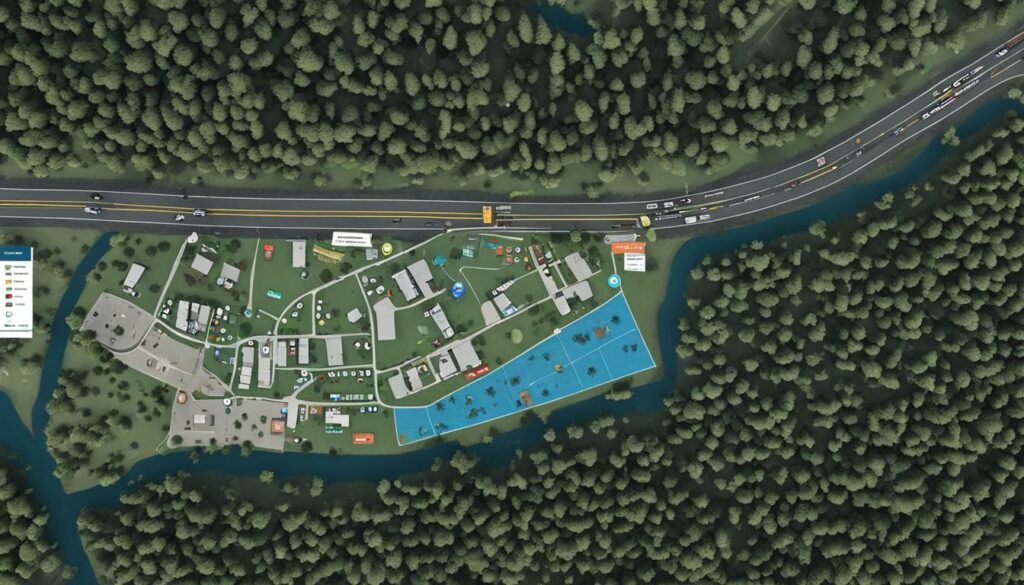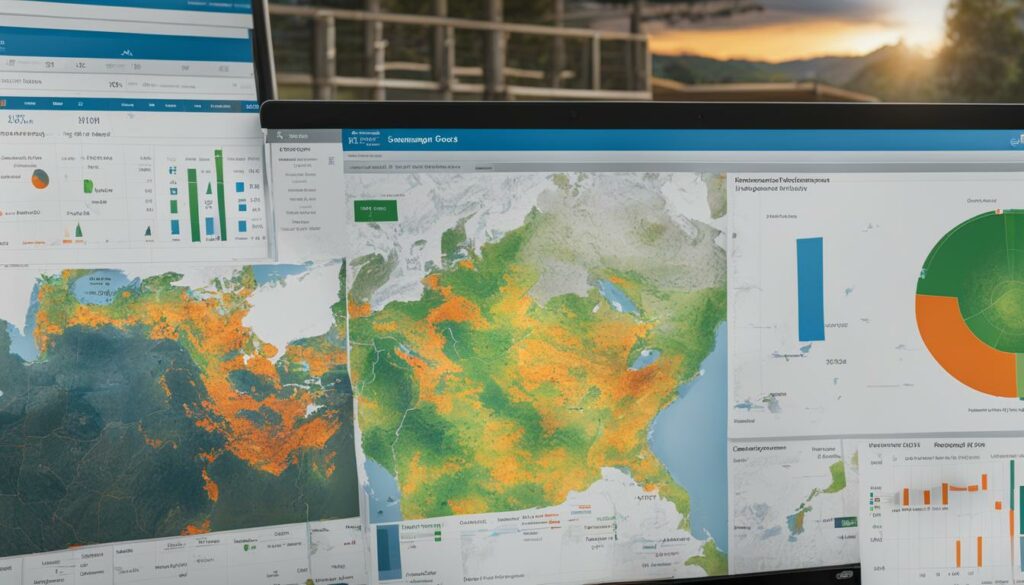Investing in campground development can be a promising venture for those seeking profitable returns. However, to ensure success, it’s imperative to conduct thorough investment analysis for campground development, evaluating market potential, financial feasibility, and site suitability.
Investment analysis provides crucial insights and helps investors make informed decisions, mitigating risks, and ensuring profitable returns. In this article, we will explore the fundamentals of investment analysis for campground development ventures and provide valuable tips to help you succeed.
Key Takeaways:
- Investment analysis is essential to make informed decisions for campground development ventures.
- Market analysis, financial feasibility, and site suitability must be evaluated in investment analysis.
- Thorough investment analysis mitigates risks and ensures profitable returns.
- Investors can unlock the potential of campground investment opportunities through comprehensive investment analysis.
- Successful campground development requires evaluation of various factors such as permits, marketing strategies, and ongoing management.
Understanding Campground Investment Analysis
For any successful campground development project, investment analysis is a critical factor. Campground investment analysis involves evaluating various factors, such as location, market demand, and financial feasibility, to make informed investment decisions.
Investors need to consider the location of the campground and assess its proximity to local amenities, natural attractions, and popular tourist destinations. This will help to determine the potential demand for camping sites and the level of competition in the area.
Market analysis is another key consideration in campground investment analysis. Investors need to analyze relevant market trends, consumer preferences, and demographics to assess the potential demand for different types of camping experiences.
Finally, financial feasibility is crucial to ensure a profitable venture. Financial analysis involves evaluating the capital investment requirements, operating costs, and revenue projections. It also includes assessing the return on investment (ROI) to determine whether the campground development project is a sound financial decision.
In summary, investment analysis for campgrounds involves evaluating the location, market demand, and financial feasibility of a potential campground development project. This helps investors make informed decisions and ensures a profitable venture in the long run.
Conducting Campground Market Analysis

Conducting a thorough campground market analysis is crucial in determining the feasibility of developing a campground project, as well as ensuring its long-term success. Market analysis involves identifying the latest trends and opportunities in the industry, analyzing competitor performance, and forecasting demand.
One of the key components of a campground market analysis is identifying the target audience. This involves researching demographics such as age, income, and interests. By understanding the target audience, developers can tailor the design and amenities of the campground to appeal to this specific segment and increase occupancy rates.
Competitor analysis is another important aspect of campground market analysis. This involves researching similar campgrounds in the area to identify their strengths, weaknesses, and unique selling propositions. By analyzing the competition, developers can differentiate themselves by providing superior facilities or experiences.
Finally, demand forecasting ensures the viability of the campground project. This involves analyzing historical data and market trends to predict future demand for the facility. Developers should pay close attention to factors such as seasonality, local events, and tourism trends to accurately forecast demand and avoid unnecessary financial risks.
Financial Analysis for Campground Development
Financial analysis is a crucial element in determining the feasibility of a campground development project. It involves evaluating the capital investment requirements, operating costs, revenue projections, and return on investment (ROI) assessment.
Capital Investment Requirements
Campground development requires significant capital investment to cover expenses such as land acquisition, infrastructure development, and equipment purchases. It is essential to calculate the total cost of these expenses accurately to attract investors and secure financing. The estimated capital investment must align with the project’s goals and financial potential, without compromising on quality or standards.
Operating Costs
Operating costs are the ongoing expenses required to maintain and operate a campground. These expenses include payroll, utilities, maintenance, repairs, insurance, and marketing costs. It is crucial to estimate the monthly and yearly expenses accurately to ensure profitability and sustainability.
Revenue Projections
Revenue projections are crucial to determine the growth potential and profitability of a campground. It requires market research, competitor analysis, and target audience identification to calculate the estimated revenue streams accurately. These projections must be realistic, conservative and reflect the operating costs for the project to be attractive to potential investors and lenders.
Return on Investment (ROI) Assessment
ROI assessment involves analyzing the profit potential of the project compared to the investment cost. It calculates the percentage of return on investment for the entire project lifespan. ROI is a key metric that investors use to evaluate the viability of a campground development project. A high ROI shows that the project is profitable and sustainable, making it more attractive for investment.
“In order to create accurate financial projections, campground developers must take into account all revenue, equity, and debt financing sources.”
Overall, financial analysis is critical in developing a successful campground project. It provides insights into the estimated capital investment requirements, operating costs, revenue projections, and the potential ROI. As such, it guides the decision-making process for investors and developers, ensuring long-term success and profitability.
Assessing Campground Feasibility

Before investing in a campground development project, it is crucial to conduct a campground feasibility study to determine its viability. This study includes various assessments, such as evaluating site suitability, zoning regulations, environmental considerations, and assessing potential risks.
When evaluating site suitability, factors such as accessibility, natural amenities, infrastructure, and location need to be considered. The site must have sufficient space to accommodate all the planned facilities, including camping sites, recreational areas, parking, and support structures.
Land use regulations also play a significant role in the feasibility of a campground development project. Investors should research the zoning laws and regulations of the city and state where they plan to set up the campground to ensure compliance with all laws and regulations. This includes studying property tax regulations, as property value assessments can ultimately affect the feasibility of the project.
The environmental impact of the development should be closely examined. A campground development may have an adverse impact on the environment if not executed properly. A thorough environmental assessment must be conducted to identify any potential environmental risks and how they can be minimized or eliminated.
Finally, assessing potential risks is crucial before any investment in a campground development project. Risks may include natural disasters and emergencies, economic downturns, or other unforeseeable events that may impact the value of the investment. Investors should research and consider all possible risks and develop contingency plans to mitigate them.
Evaluating Campground Development Opportunities
Investing in campgrounds can be a lucrative venture. However, choosing the right type of campground that meets market demand is crucial for ensuring profitability. This section explores various campground investment opportunities and highlights their potential advantages and disadvantages.
Luxury Resorts
Luxury resorts cater to campers who desire high-end amenities and have a higher disposable income. They often include features such as swimming pools, spas, and fine dining options. However, starting a luxury resort requires a significant investment and ongoing maintenance costs, making it a riskier option for novice investors.
Tent-Only Sites
Tent-only sites can be an attractive option for nature enthusiasts who prefer a more minimalist camping experience. This type of campground typically has lower operating costs than luxury resorts. However, they require a well-chosen location with good access to natural attractions to attract campers.
RV Parks
RV parks cater to campers who want to travel with their recreational vehicles. This type of campground has lower startup costs and requires less ongoing maintenance than luxury resorts. However, RV parks have lower revenue potential than luxury resorts and require amenities such as electricity and clean water to keep campers comfortable.
Campgrounds Near Attractions
Campgrounds located near popular tourist attractions such as national parks, beaches, and theme parks can generate significant revenue. They cater to campers who want to explore nearby attractions during the day and return to a comfortable campsite at night. However, competition can be high, and operating costs can be expensive in popular locations.
Each type of campground offers unique benefits and risks. Before investing in a campground, thorough investment analysis for campground development is essential to identify the most profitable option.
Analyzing Return on Investment (ROI) for Campground Development

Calculating return on investment (ROI) is essential to determine the profitability of campground development ventures. ROI measures the amount of return, or profit, on an investment relative to the initial cost of that investment. It is a widely used performance metric for investment analysis.
ROI is calculated as follows:
ROI = (Gain from Investment – Cost of Investment) / Cost of Investment x 100%
ROI can be expressed as a percentage, where a higher percentage indicates a more favorable return on investment. ROI is useful for comparing different investment opportunities and determining the most profitable option.
Assessing Payback Period
In addition to ROI, it is also important to assess the payback period of campground development investments. The payback period is the amount of time it takes for the initial investment to be recouped through the generated revenue.
Calculating payback period provides insight into the length of time it will take for a campground development venture to become profitable. This information can be used to make informed decisions about financing and ongoing operations.
Considering Long-Term Sustainability
When analyzing ROI for campground development ventures, it is important to consider long-term sustainability. This includes evaluating potential risks, ensuring compliance with regulations, and implementing environmentally conscious practices.
A sustainable campground development venture will not only generate a profitable return on investment but also promote responsible land use and preserve natural resources.
By conducting a comprehensive ROI analysis, assessing the payback period, and considering long-term sustainability, investors can make informed decisions and achieve profitable and sustainable campground development ventures.
Mitigating Risks in Campground Investment
Investing in campgrounds can be profitable, but it also comes with risks. Therefore, mitigating these risks is crucial for long-term success. This section explores strategies to minimize potential risks associated with campground investments, such as:
Insurance
Campground owners should consider purchasing insurance coverage to protect against damages to property, liability claims, and other unforeseen events. Insurance policies should also include coverage for natural disasters, such as floods and wildfires, which can cause significant losses.
Emergency Preparedness
Developing an emergency preparedness plan can help mitigate risks and ensure the safety of campers and employees. This plan should include procedures for responding to emergencies, such as severe weather, power outages, and medical emergencies.
Legal Considerations
Understanding and complying with applicable laws and regulations is vital for mitigating legal risks. Campground owners should seek legal advice to ensure compliance with zoning and land-use regulations, employment laws, and health and safety regulations.
By implementing these strategies, campground owners can mitigate potential risks associated with campground investment opportunities. Taking proactive measures to manage risks can help ensure the long-term success and profitability of campground ventures.
Financing Options for Campground Development

Developing a campground can be a costly venture, and securing financing is a critical step in the process. Fortunately, there are several financing options available to investors looking to develop a campground.
Traditional Bank Loans
One of the most common financing options for campground development is through a traditional bank loan. With a bank loan, investors can borrow a specific amount of money with a fixed interest rate and repayment period. Banks will require a detailed financial analysis of the project, including projected revenue and expenses, before granting the loan.
Government Grants
Government grants are another financing option for campground development, particularly for projects that benefit the community. The US Department of Commerce’s Economic Development Administration and the US Department of Agriculture’s Rural Development Program are two examples of government organizations that offer grants to support campground development.
Partnership Opportunities
Partnering with another investor or company can help spread the costs and risks associated with campground development. Partnerships can take the form of joint ventures, where each partner invests money and shares in the profits, or financing partnerships, where one partner provides financing while the other handles the development and management of the campground.
Crowdfunding
Crowdfunding has emerged as a popular financing option for campground development in recent years. Through crowdfunding, investors can reach a large group of potential investors through online platforms to secure financing for their project. This financing option can provide quick access to funds and allows investors to connect with a wider network of like-minded individuals.
“It’s important to thoroughly research each financing option to determine which one aligns best with your business goals and financial position.”
Steps to Successful Campground Development
Developing a campground requires a well-defined strategy to ensure success. In this section, we will explore the key steps involved in successful campground development analysis, including:
- Site selection: Choosing a suitable location is critical to the success of a campground project. Consider factors such as access to natural attractions, proximity to urban areas, and environmental impact.
- Permits and licenses: Obtain all necessary permits and licenses, such as zoning approval, environmental permits, and business licenses. Failure to secure these approvals can result in legal liabilities and financial losses.
- Construction process: Follow the construction timeline, ensuring that all activities comply with legal requirements and quality standards. Hire a reputable construction team and supervise the project closely to avoid any delays or errors.
- Marketing strategies: Develop an effective marketing strategy to attract customers and build brand awareness. Utilize social media platforms, search engine optimization, and promotions to increase visibility and attract potential customers.
- Ongoing management: Once the campground is operational, ongoing maintenance and management are critical. Ensure that the facilities are well-maintained, staffing is adequate and effective, and customer service is prioritized.
By following these steps, campground developers can ensure that their projects are successful, profitable, and sustainable for years to come.
Conclusion
Investment analysis is a critical process for any successful campground development project. By conducting comprehensive market and financial analyses, assessing feasibility, and mitigating risks, investors can unlock the potential of campground investment opportunities and achieve long-term success.
It is important to keep in mind that investing in campground development requires a significant amount of time, effort, and financial resources. Therefore, it is essential to carefully evaluate campground development opportunities, conduct due diligence and seek professional advice before making any investment decisions.
Ultimately, by following the key steps involved in successful campground development, such as site selection, permits and licenses, construction process, marketing strategies, and ongoing management, investors can maximize their returns and create a lasting impact in the campground industry.
FAQ
What is investment analysis for campground development?
Investment analysis for campground development refers to the process of evaluating the financial feasibility and potential profitability of investing in a campground project. It involves assessing various factors, such as market demand, location, financial projections, and return on investment (ROI).
Why is investment analysis important for campgrounds?
Investment analysis is crucial for campgrounds as it helps investors make informed decisions about the viability and profitability of a development project. It allows them to identify potential risks, evaluate market demand, calculate financial projections, and determine the return on investment (ROI).
How do you conduct campground market analysis?
Conducting campground market analysis involves researching and analyzing various aspects of the campground industry, including market trends, competitor analysis, target audience identification, and demand forecasting. This helps in understanding the market dynamics and identifying unique selling propositions to attract the desired customer base.
What is financial analysis for campground development?
Financial analysis for campground development involves assessing the financial aspects of a campground project, including capital investment requirements, operating costs, revenue projections, and return on investment (ROI) assessment. It helps in understanding the financial feasibility and potential profitability of the project.
Why is campground feasibility study important?
A campground feasibility study is important as it allows investors to evaluate the viability and potential risks of a campground development project. It involves assessing factors such as site suitability, zoning regulations, environmental considerations, and potential risks to determine if the project is feasible and sustainable.
What are the different types of campground investment opportunities?
There are various types of campground investment opportunities, including RV parks, tent-only sites, luxury resorts, and themed campgrounds. Each type of campground offers different advantages and target markets, allowing investors to choose the option that aligns with their investment goals and target audience.
How do you analyze the return on investment (ROI) for campground development?
Analyzing the return on investment (ROI) for campground development involves calculating the ROI, considering factors such as initial investment, ongoing costs, and projected revenue. It also requires assessing the payback period and considering long-term sustainability for a comprehensive ROI analysis.
How can risks in campground investments be mitigated?
Risks in campground investments can be mitigated through strategies such as obtaining insurance coverage, implementing emergency preparedness plans, complying with legal requirements and regulations, conducting thorough due diligence, and diversifying the investment portfolio.
What financing options are available for campground development?
Financing options for campground development include traditional bank loans, government grants, partnership opportunities, and crowdfunding. Each financing option has its own requirements and benefits, and investors should carefully evaluate the available options to determine the most suitable financing strategy for their campground project.
What are the key steps to successful campground development?
The key steps to successful campground development include site selection, obtaining permits and licenses, managing the construction process, implementing effective marketing strategies, and ensuring efficient ongoing management. Each step is crucial for the successful development and operation of a profitable campground.





